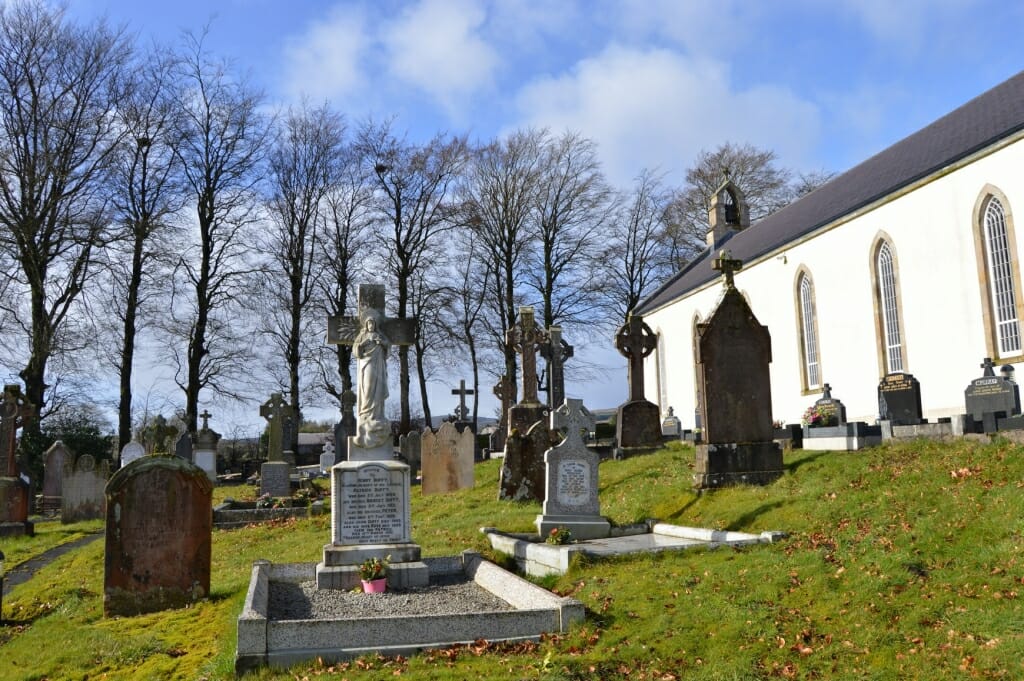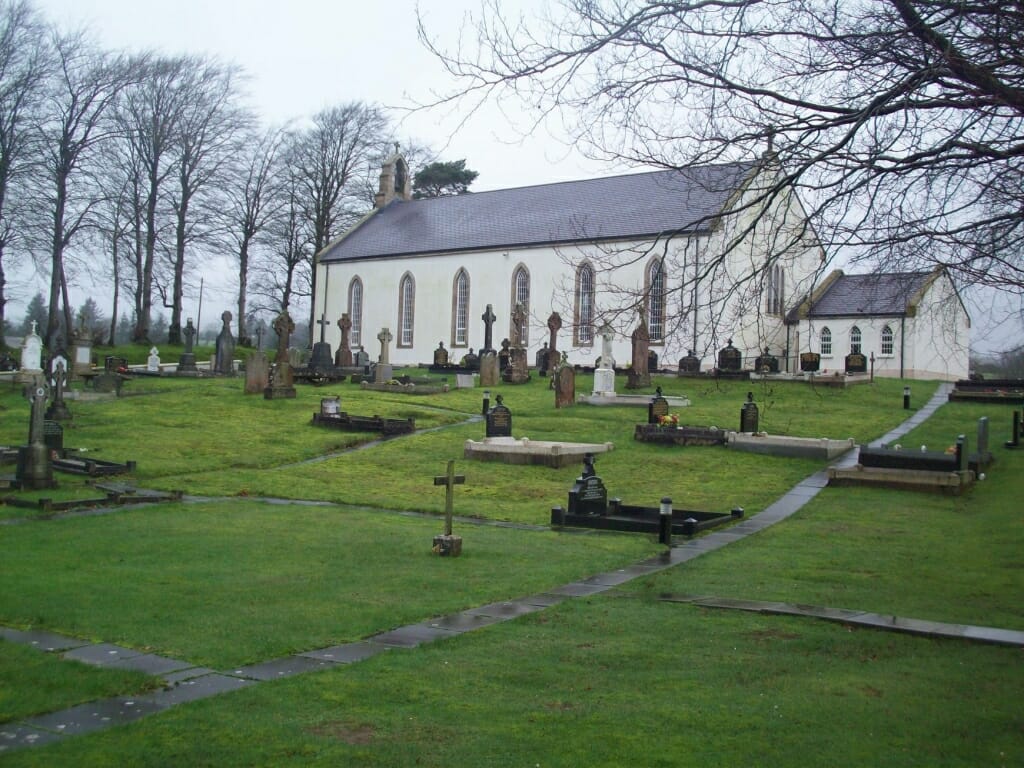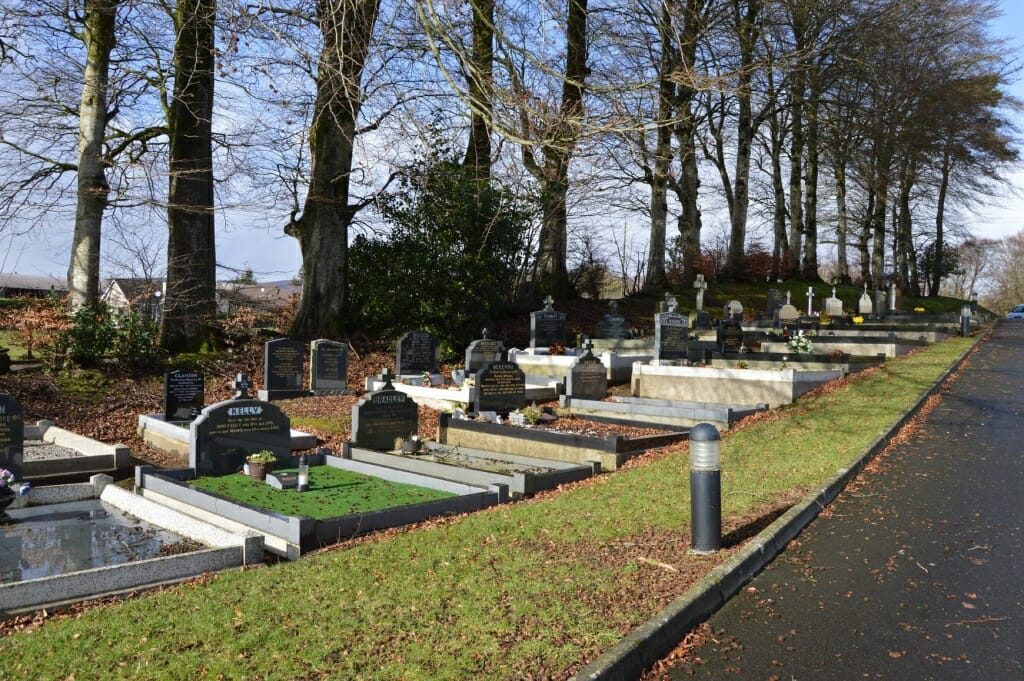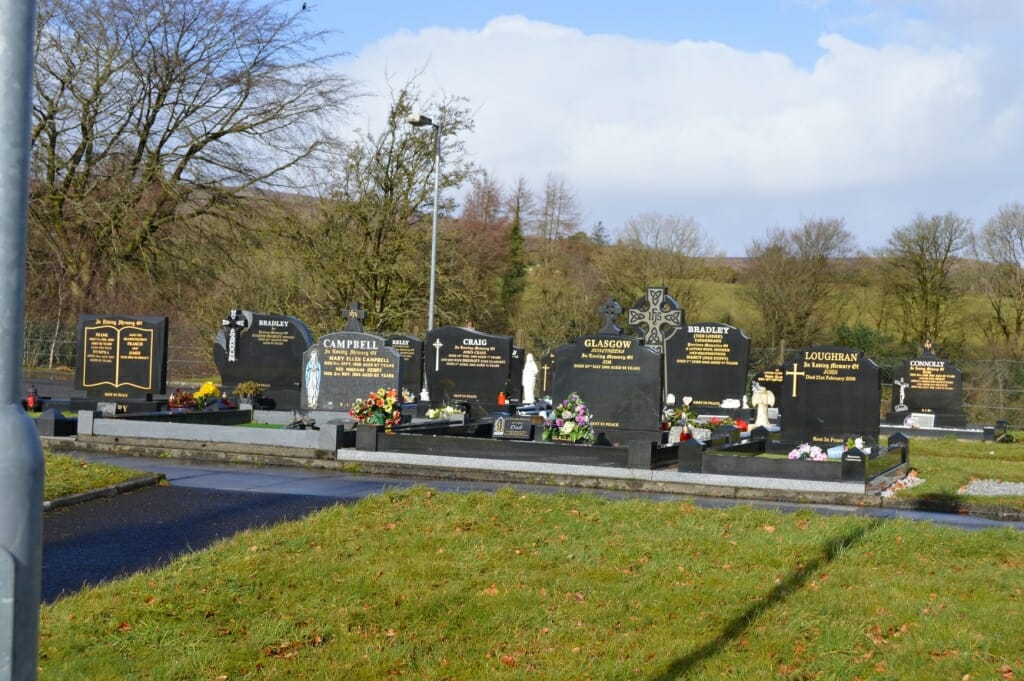St. Patrick`s Church, Sixtowns.
By the beginning of the seventeenth century the old church at Moneyconey had fallen into disuse and there followed a period during the Penal times when we are not really sure of what sort of services were available to the people of the Sixtowns. We do know that during the Penal times mass was often said in the open and secluded places around the parish. One such place for the people of the Sixtowns was the mass rock in Glengamna which has been beautifully restored by the McBride family and lies along the sheltered bank of the Glengamna river.
Whatever the situation was, the people of the area did not have a known house of worship and there would be no access to one until the old barn church was built in Straw in 1809, a period of 200 years or more later. It is obvious that the parishioners of the Sixtowns would have walked all the way to Straw for mass, and this after fasting for the previous 24 hours, in many cases. Eventually, when the present church was built at Straw in 1853, the parishioners from the Sixtowns must have decided that it must be time for them to have their own church building too. The plans were drawn up but the parish priest of the time soon let it be known to them that he was not in favour of it. When it became clear to him that the people were determined to have their own church building, with or without his consent, he is reputed to have put a curse on anyone who attempted to get involved in any way with the building of this chapel. The desperate people sought the advice from a popular curate in the parish on what they should do. The curate secretly supported them and told them not to worry but to carry on with the project because “a curse will never fall on a just cause “. So the building progressed and the contract was taken on by James McNally (Glenviggan) and Roger Bradley (Moyard) while other people volunteered their services free to see the project finished. The carpenters who did the work were called Cassidy and stayed in local houses and there were chairs in several houses right up until the 1950`s which were made by them while they stayed, which is a testament to their craftsmanship. The same can be said of the work which they carried out in the chapel, much of it still to be seen today. There is a story about a local man who still feared the power of the P.P`s curse, but, being a nosey sort, just could not resist the temptation to visit the workers and while he was up on a scaffold viewing the work, he began to warn the men about the curse that might still befall all of them. As he was talking a tradesman who was busy building beside him as he spoke, suddenly said to him, “ reach me that wee stone over to fill in this space.” Never thinking about it the man handed him the stone, upon which the mason said “now, that`s you involved too.” At that the man is said to have hurried home in panic and was to have taken to his bed for a week in fear of the repercussions of what he had done.
There is another account of a young man from Moneyconey called Bradley (Micheal Cormac) who volunteered to bring lime for the building from Desertmartin. It is said that he arose early one morning, walked to the top of Moneyconey mountain and caught his horse. He brought it down, yoked it in its cart and headed for Desertmartin for a load of lime. He arrived back with it, took his dinner and fed his horse and headed back for another load the same day. The horses were a small hardy Scotch breed and the old people claimed that “you couldn’t kill them with work,” even though we can be sure they had tried.
After some time, when it was becoming clear to the P.P. that the determination of the people would win out, he eventually gave in and an agreement was reached to knock down a corner of the building as a sign of their submission to ecclesiastical authority, invite the bishop to lay the foundation stone and allow the project to be finished. The ground on which the church was built was given free of rent by the landlord, Stevenson of Fortwilliam, Tobermore. The chapel was opened in 1854 and round the perimeter of the grounds beech trees were planted and many of them remain to this day.
The ones along the main road were cut down during renovations for the centenary celebrations in 1957. Some others which were diseased have recently been cut down. The church has had various bits of repair work done over the years but it still retains much of its origional character. During recent renovation work an architect commented on how straight and plum the walls were, which is a considerable tribute to the stonemasons who worked on it and who had not got the benefits of modern technology. The church has been restored beautifully in 2005 with no expense spared and should be there for many future generations to come. During this renovation the bell tower was rebuilt. This bell used to call people to pray, announce deaths or simply let people know that mass was about to start. On one occasion as a young man began to ring the bell for the start of mass, and as he was doing so the tongue of the bell came out of the bell and hurtled down towards the ground, sticking into the very spot where a group of men had been standing chatting seconds before. But for their punctual obeyance to the bell toll, someone of them would surely have been killed.
The graveyard.
The graveyard in the church used to be bordered on two sides by a beech hedge which has since been removed to build a wall during the 1980`s.The graves are said to have been laid out in two areas.
Apparently, there had always been local rivalry between the people of the upper and lower ends of the Sixtowns in the early days and there would be the odd row at school or on the way home from fairs when there would have been a bit of liquor consumed. As a result of this, the people of the upper end of the Sixtowns tended to bury in the top half of the graveyard while those from the bottom end buried in the lower part of the graveyard. One old man from Moyard who was on his death bed, began to worry when he was informed that the family plot was filled, cried out in vain “Surely you won`t end up burying me down with the Tullybrick ones”. Headstones tended to be mostly in the upper or western end of the graveyard. Possibly the oldest headstone in the graveyard belongs to the Connolly family of Strannahinch, in Moyard. It reads “In memory of Francis Connolly (Strannahinch) who died January 1850, aged 56. Of course it is also quite possible that the headstone was erected at a later date as it also carries the name of “ his wife Bridget who departed this life Dec 8 1879 aged 80 years.” There are some fine headstones from that date onwards and no doubt they cost a lot of money at the time. Many would have been built by family members who had emigrated to America as there would not have been a lot of money around the Sixtowns in those times. One headstone is table shaped, like two others in the graveyard, and reads;
Erected by Loughlin Bradley
Of Thornville, Chester County, Penn. U.S.A.
In memory of his father, Francis
Who died Feb. 1 1858
Aged 74.
(There is a mistake in the above headstone inscription. Thornville should read Phoenixville. That is where this Loughlin Bradley lived. There is no Thornville in Chester County.)
Another headstone which was erected by an emigrant for his father and mother was that of Daniel and Anne McBride of Moneyconey. Another reads;
Erected by Peter Bradley
Of Brooklyn U.S.A.
In memory of his beloved parents
Patrick who died
July 6 1897 aged 60
And Mary who died Feb.22 1935 aged 91.
This man emigrated from Moneyconey and like the others who are mentioned above, never forgot those who reared them or their respect for their families.
The most regrettable thing about this graveyard is that the parish kept no records of where anyone was buried. This makes it impossible to identify any grave which has not got a headstone. .As it stands now, most of the old people who could point out the wherabouts of or identity of graves, are dead and gone. In 1957 when the graveyard was being tidied up for the centenary celebrations, the men merely shaped the top of the ground into what looked like well set out graves. This masked the real truth that graves lay in every direction all over the lower end of the graveyard.
Another poignant aspect of the graveyard is the burial place of the stillborn and unbabtised babies which lies on the ditch next to the community centre. These babies, according to misguided theology at the time were not deemed to be worthy of burial within consecrated church grounds. Thankfully the Catholic church has recognised the error of their ways and has expressed its regret but will future generations know that this ditch is a burial site?
There were once toilets at the road end of the graveyard close to the wall of the community centre. There was also a coach house at the rear of the chapel where horses could be kept during mass. It was demolished during the renovations in the 1980`s. The last horse and trap to come to mass in the Sixtowns in the late 1950`s belonged to the Brown family of Glengamna. The occasion was most likely to have been a sort of last hurrah for the horse and trap because the family had also got a Land Rover at the time. Michael McCullagh of Bancran remembers being hired as a boy in Browns and how his job on a Saturday night was to polish up the brass on the harnesses to be ready for going to mass in the morning in Sixtowns. He remembers coming home one Sunday in a lightening storm and meeting someone on the road who told them that war had broken out in Europe. It was September 1939. This had been the mode of travel to mass for people in far away parts of the Sixtowns for a long time and many old people depended on it to get to mass and other places .Locals tell a story about an old woman who lived somewhere in the lower end of the Sixtowns who became too old to walk to mass. A very kind neighbour called Robert Sinclair, a Presbyterian himself, took out his horse and trap and brought her to mass and came back for her after it was over. This underlines the harmony between co religionists which has always been in existence in the Sixtowns.
By the 1950`s a handful of people had purchased cars, while others used tractors with an improvised seat on the back to bring their family members to the chapel. One look into the modern day car park would make you realise how difficult it is to explain to the young people of the area that this was the situation less than 50 years ago. In the late 1950`s, most people would remember the road from Joe Conway`s (Dan) up to Johnnie McNamee`s (Molly) thick with people in rows of threes and fours walking home from mass. At that time also there would have been six or seven bicycles heading down the Moyard road to mass on Sunday. The chapel on a Sunday was not only an opportunity for people to pray but it was also a social occasion and a meeting of the community. If someone was not out at the chapel on Sunday, questions would be asked as to their wellbeing and in the same way if a person had been sick for a while it was most important to be seen out at the chapel as soon as possible to show the scaremongers that their demise was greatly exaggerated. Nowadays, it is so different as people all have cars and can choose which mass and where they attend. The only day of the year which could be viewed as being a community day at the Sixtowns chapel, is graveyard Sunday, a relatively new phenomenon but one which brings everyone with relatives buried in the graveyard together to renew old acquaintances and friendships.
PHOTO FROM 50`S
Stories from St. Patrick`s Church.
There would always have been missions at the chapel down the years when in earlier times the missionaries would have been firebrands who would have put the frighteners on the locals with their fiery sermons. One story is told about a missionary who was giving the young men folk a fiery lecture about chastity and how they should behave toward their girlfriends. After the mass was over the men were discussing the merits of his lecture most agreeing until one old character spoke up saying, “I wouldn’t agree with him at all for I think that the women are like the turf, if you don`t handle them, you won`t get them”. On another occasion a missionary was giving a stern lecture to the congregation about how men often treat their wives really badly, giving examples of this kind of behaviour as he went A local character who was known to have had his battles with his wife and had a few drinks in him, somehow got the impression that the mission priest was aiming his sermon at him and spoke up, shouting up, “Houl` on now father, houl` on til you hear my side of it.” Nowadays the firebrand approach has gone and the missionaries tend to use humour and get the people with them in their thinking.
Today the graveyard is lit up at night and has pathways made through out for the pilgrims. In recent years the burial ground has spread out into the area across the drive up to the chapel and round the back beside the car park.
Centenary Year 1957.
The year 1957 was the centenary of the opening of St. Patrick`s Church in Sixtowns. Fr. M. Collins decided that there would be big celebrations held in order to celebrate the occasion. A band was formed and they practised and marched on the road until they got all their tunes and marching right . Funds were raised to pay for the instruments and there was a great sense of community engendered as a result of these activities. Local people would sit along the hedges in the summer evenings to watch the band march up and down the Sixtowns road playing tunes like The Moon behind the Hill and the Three Flowers.
On the march.
Huge preparations were made for the centenary, including the cutting down of the large beech trees along the road, the landscaping of the graveyard and the renovations to the church building. In the schools the choir and altarboys were busy getting everything right for the day.There was a great buzz around the place as people came along to offer their services. In those days the arrival of the Bishop was something akin to the arrival of the Royal family, with the roads bedecked with papal flags and bunting, cavalcades of cars accompanying the Bishops chauffeur driven limousine to the chapel. Parishioners were lined from the gate in to the church waiting to kiss the Bishops ring. There was a large contingent of clergy in attendance and they co celebrated mass with the Bishop. This was indeed a huge occasion for the large crowds of parishioners who attended that day.


















